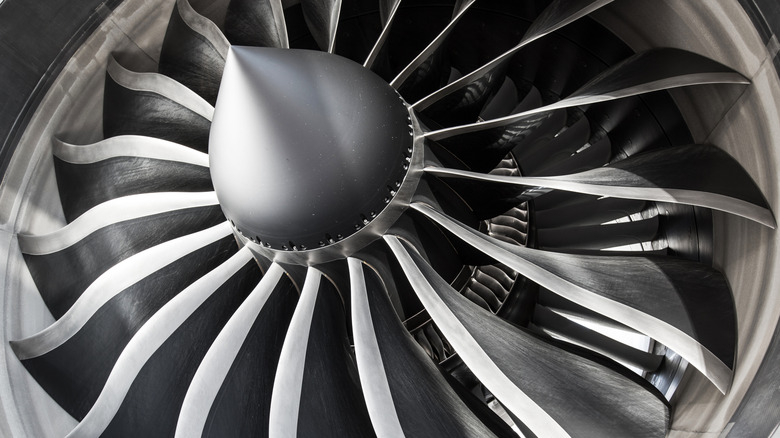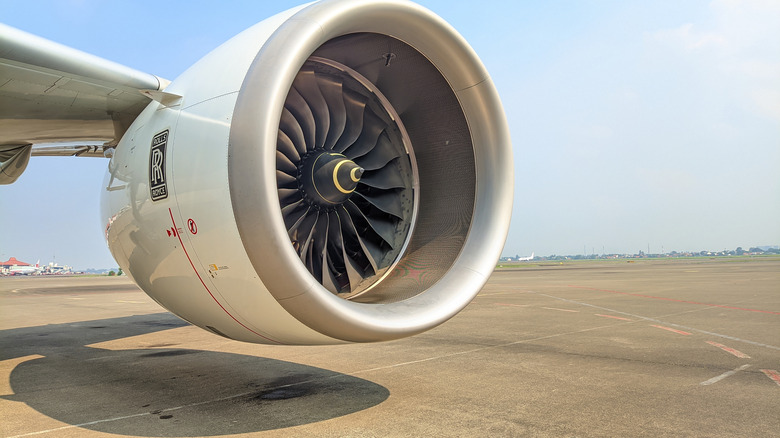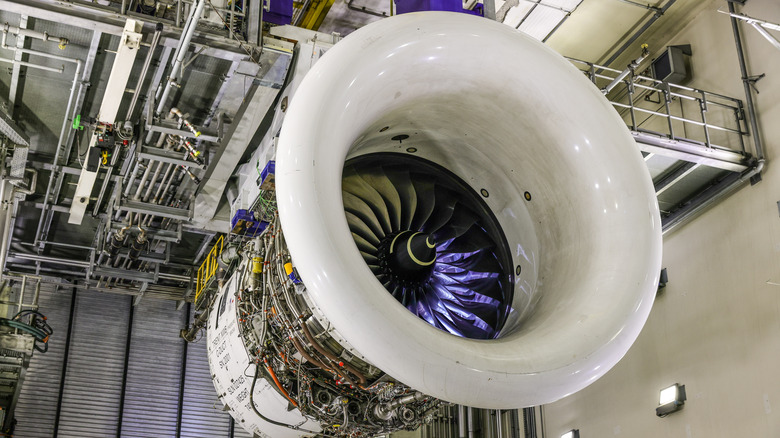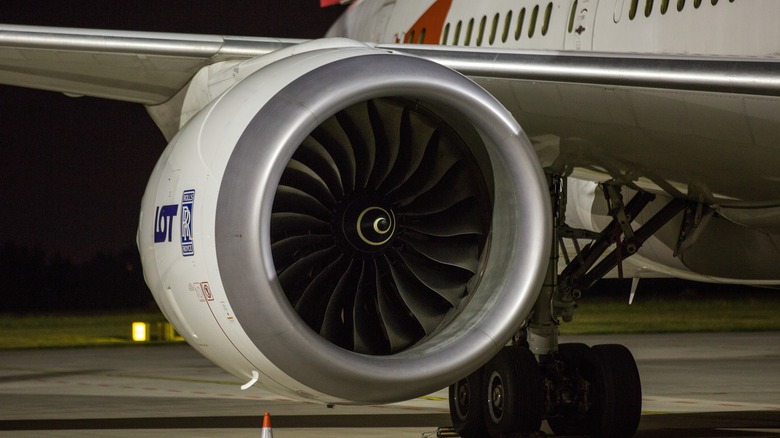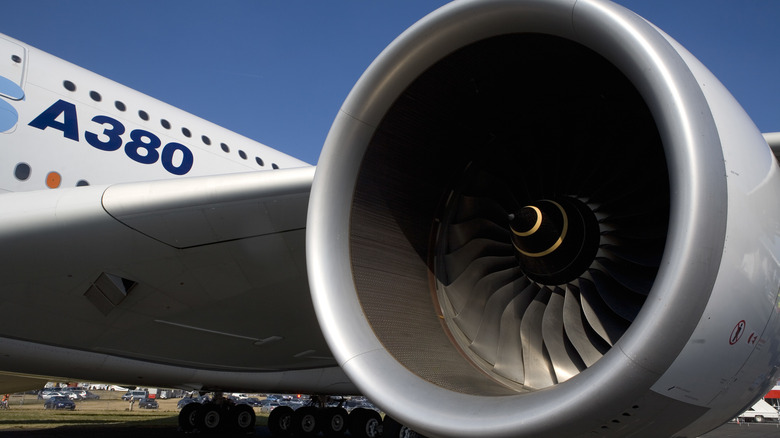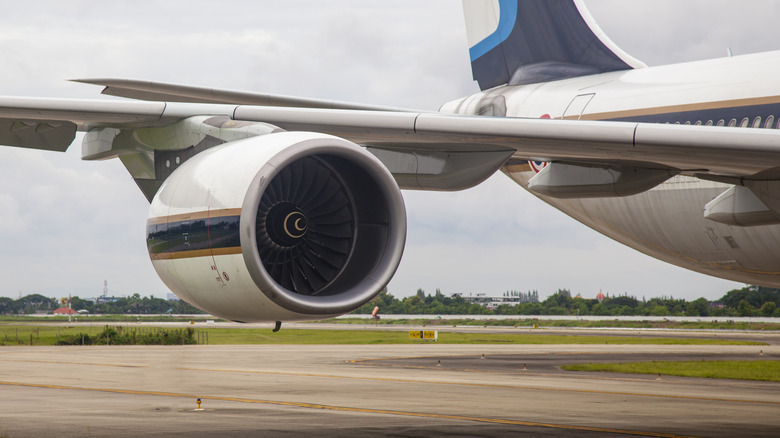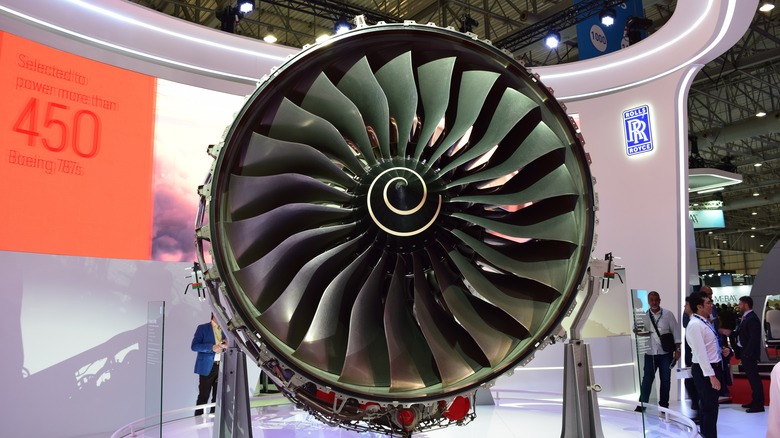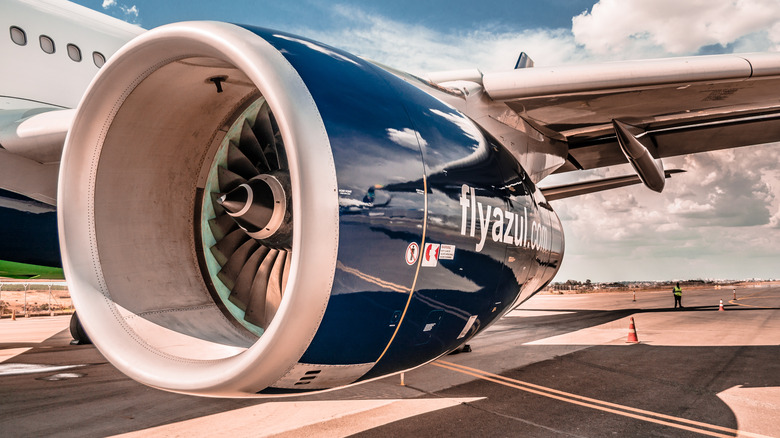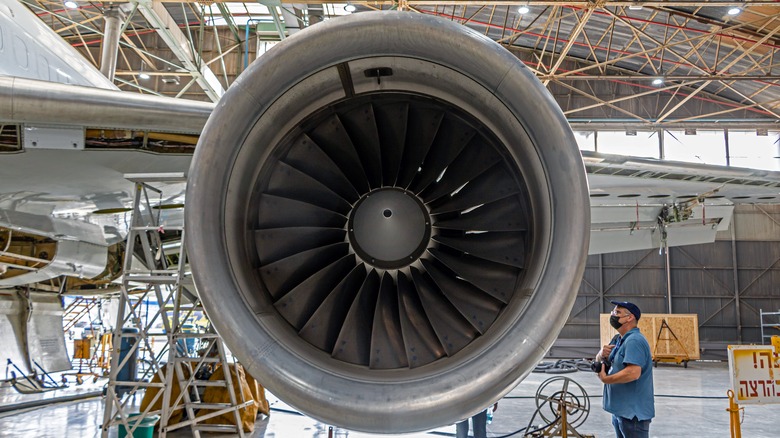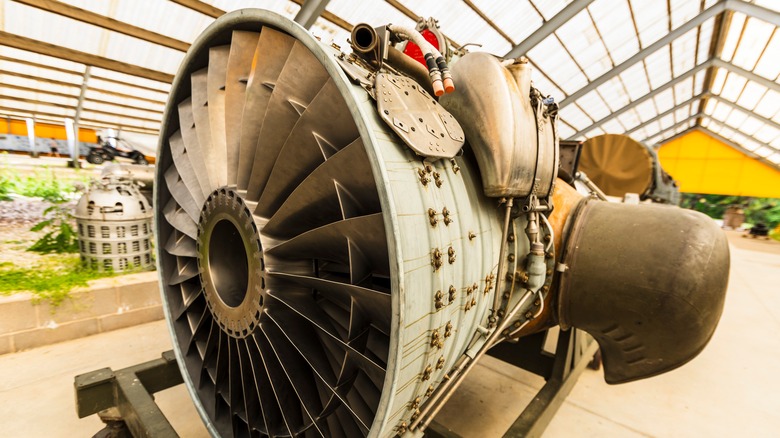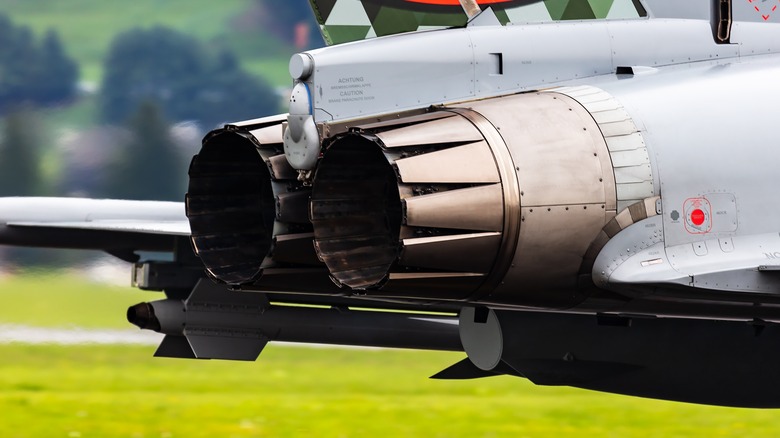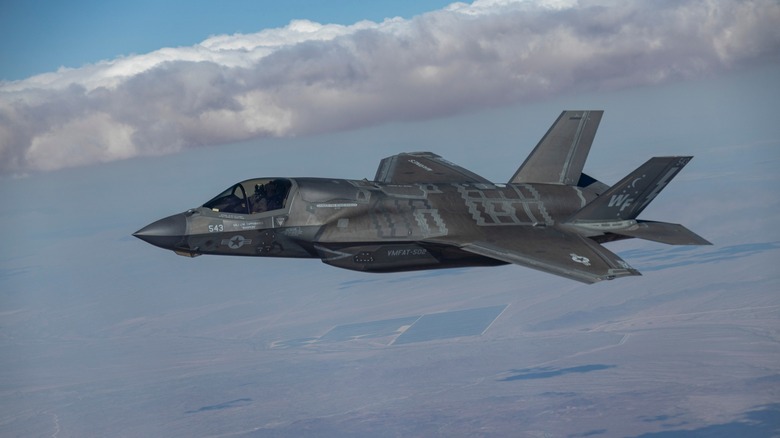What Jet Engines Are Made By Rolls-Royce? Here's What You Need To Know
To many people, the name Rolls-Royce is associated with classic cars. Vintage vehicles like the Rolls-Royce Phantom have appeared in James Bond films and set the standard for luxury. However, Rolls-Royce is actually much more of a success in the aerospace industry. For more than 100 years, the company has been designing and manufacturing aircraft engines and is now a global leader in the market.
As a jet engine manufacturer, Rolls-Royce products provide the propulsion for dozens of types of aircraft currently in use today. The company has thousands of engines in operation and is well regarded for its reliability, efficiency, and performance. Among the many different jet engines Rolls-Royce makes, the Trent variants are the most common, powering over 50% of all wide-bodied passenger and cargo jets in the world.
Some of these Rolls-Royce turbofan engines are fitted to the most iconic Boeing jets ever made as well as other brands like Airbus. In fact, Rolls-Royce even provides the engines for some impressive military fighters.
Trent 7000
The Rolls-Royce Trent 7000 is one of the company's most recent products. It officially entered service in 2019 and has since proven to be one of Rolls-Royce's most reliable and efficient turbofan engines. Based largely on the technology used to create the Rolls-Royce Trent XWB, it is 9 feet, 4 inches in diameter and is made up of 20 individual fan blades. Weighing more than 14,000 pounds, the Trent 7000 can provide up to 72,834 pounds of thrust with an improved bypass ratio of 10:1, making it twice as efficient as the earlier Trent 700. It is also six decibels quieter and has a value of 14% better fuel economy than its predecessors.
The Trent 7000 was built exclusively for use on the Airbus A330neo. This is a new version of the wide-body airliner that was developed to offer a viable alternative to the Boeing 787 after airlines expressed interest in a more efficient smaller aircraft. There have been several hundred orders of the aircraft, with operators including Delta Air Lines and Condor. It can carry between 220 to 300 passengers depending on the exact variant and is capable of reaching a top speed of 540 mph over a maximum range of just over 8,000 nautical miles.
Trent XWB
The Rolls-Royce Trent XWB is another recent turbofan engine. First announced in 2006, the engine entered service in 2015. Like other Trent designs, the Trent XWB has a three-shaft shape but has a total of 22 fan blades. That gives the engine a bypass ratio of 9.6:1 — high but not as efficient as the Trent 7000. But what it lacks in total efficiency it makes up for in sheer power. The Trent XWB is the company's most powerful engine and can produce a maximum thrust of 97,000 pounds, making it an ideal choice for ultra long haul flights. Rolls-Royce claims this model is 15% more efficient than older versions and can provide more than $6 million dollars annually in fuel savings for each aircraft.
It is little wonder, then, that more than 2,000 Trent XWB engines have been ordered by at least 60 operators. The two variants of the engine, known as the Trent XWB-84 and Trent XWB-97, power various versions of the Airbus A350. This aircraft is capable of carrying up to 480 passengers and can reach a top speed of 591 mph. Competing with the Boeing 777 and Boeing 787, it is flown by the likes of Singapore Airlines and Air France.
Trent 1000
The Rolls-Royce Trent 1000 emerged in the early 2000s as a successor to the Trent 900. It officially entered service in 2011 following several years of testing and development, with the company claiming it has had a 99.9% reliability rating. With a bypass ratio of 10:1 and maximum thrust of 78,000 pounds. It also features a heated engine section stator and other safety features to protect against engine icing.
Rolls-Royce suffered something of a crisis in 2016 when it emerged that some of the Trent 1000 engines in service had become damaged. The problem was caused mainly by two factors; the increase in air pollutants causing sulfidation and a design flaw in the nickel alloy used to coat some of the engine blades. The problem grounded dozens of aircraft and cost Rolls-Royce billions of dollars.
As one of the two options for the Boeing 787 Dreamliner, the Trent 1000 competes with the General Electric GEnx as customers choose which power source to use. The aircraft can reach speeds of 650 mph (Mach 0.85) and has a range of over 9,550 miles. Around two thirds of the Boeing 787 Dreamliners in operation use the GEnx engine, with the Trent 1000 failing to establish itself as the market leader.
Trent 900
Like the other engines in the Trent family, the Rolls-Royce Trent 900 is a high-bypass turbofan. Originally intended for use on a possible Boeing 747 variant, but repurposed after the project was shelved, it included fuel burn improvements and new aerodynamic designs to increase the overall efficiency, with a maximum thrust of 70,000 pounds.
The Trent 900 entered the market in 2007 following extensive delays. Rolls-Royce had first announced the turbofan engine more than a decade earlier in 1996, but was forced to delay the project because of the fact that the aircraft it was being developed for also faced hold ups. By the time production was restarted, the company said it would attempt to construct up to 100 units of the Trent 900 annually.
The engine is used exclusively as the engine for the Airbus A380, continuing a partnership between Airbus and Rolls-Royce that stretches back decades. The A380 is a widebody airliner that is used by a number of operators but is most closely associated with Emirates. It can seat more than 500 passengers in normal configurations and has a maximum cruise speed of 561 mph — impressive given that it is over 238 feet long and can weigh up to 1.2 million pounds.
Trent 500
The Rolls-Royce Trent 500 is a continuation of the Trent 700 and Trent 800 engines, as well as the earlier RB211 engine. As such, it features the signature three spools that are commonplace in the Trent family of turbofan engines. With a bypass ratio of 7.5:1 and a maximum thrust of 56,000 pounds, the Trent 500 first flew as part of tests in 2000 before entering service in 2002. It was the first engine manufactured by Rolls-Royce to feature what the company calls "high technology tiled combustor design" and is quieter and more efficient than its predecessors.
The Airbus A340 is the exclusive aircraft that makes use of the Trent 500 engine, although the passenger jet was originally going to be equipped with a GE Aviation engine before those plans were scrapped. The Trent 500 is used on both the A340-500 and A340-600 variants, but was produced in relatively low numbers due to the fact that the A340 simply wasn't as successful as Airbus had anticipated. Only a handful of A340-500 and A340-600s are still in regular operation, meaning the Trent 500 is not as well known as some of the other engines in the Trent family. It is still a respectable engine, though, allowing the aircraft to reach a cruise speed of 549 mph at altitudes of 41,000 feet.
Trent 800
The Rolls-Royce Trent 800 was just the second turbofan engine produced bearing the Trent name and a slight evolution of the Trent 700 concept. Able to produce thrust of 95,000 pounds, it has accumulated over 29 million flight hours since its introduction in the early 1990s. The engine is still being used today, but Rolls-Royce is also offering an upgraded version. Known as the Trent 800EP, it is even more efficient, promising hundreds of thousands of dollars in fuel savings annually. The company was also forced to introduce changes to help prevent icing issues that had led to some engine failures.
While the Trent family of engines has been more traditionally associated with Airbus aircraft, the Trent 800 was developed specifically for the Boeing 777. A long-range wide-body airliner, the aircraft became the world's largest twinjet and is still used for long-haul flights today. As was more common at the time, Boeing offered customers the opportunity to use several different engines on the Boeing 777. This included both the General Electric GE90 and the Pratt & Whitney PW4000, although Rolls-Royce was ultimately able to capture just under half of the market thanks to its impressive reliability and lighter weight.
Trent 700
Based on the same three-shaft design of the RB211 engine, the Rolls-Royce Trent 700 was launched in 1995. Producing 72,000 pounds of thrust, the engine has accumulated more than 60 million hours in service. The reliability of the Trent 700 was proved in 2018 when an engine fitted to a Russian airliner was in service for a decade across 50,000 flight hours without needing to be overhauled, setting a record for an engine of this type.
Developed for the wide-body aircraft twinjet Airbus A330, the Trent 700 set a new standard for Rolls-Royce passenger jet engines that would come over the next two decades. The Airbus A330 comes with a choice of three engines. This includes both the General Electric CF6 and the Pratt & Whitney PW4000 in addition to the Trent 700. However, the Rolls-Royce engine was the market leader, with 60% of A330s coming equipped with the Trent 700.
Like the Trent 800, Rolls-Royce ultimately decided to upgrade the turbofan engine to incorporate newer technology from its more recent products. These allow the Trent 700EP to be more fuel efficient and older versions of the engine can be retrofitted with some of the upgrades.
RB211
The Rolls-Royce RB211 is an engine that was first produced in 1969 and was intended to drive Rolls-Royce forward and establish it as a major player in the aerospace industry. Originally developed for the Lockheed L-1011 TriStar, the partnership was not initially a great success but the company was eventually able to reposition and form an agreement with Boeing that would see the RB211 become one of the most important aircraft engines of modern times. The turbofan engine introduced a revolutionary three-shaft design that is more efficient and requires fewer parts, making it attractive to airlines as a cost-saving measure.
Revisions to the RB211 to increase its performance and efficiency led to Boeing offering customers the choice to use the engine with the Boeing 747 alongside the Pratt & Whitney JT9D. Later variants of the turbofan engine were fitted to the Boeing 757 and Boeing 767, demonstrating the flexibility of the engine and its success in the market. In fact, versions of the RB211 are still in use today, with Rolls-Royce continuing to supply engines for Boeing 747 aircraft that are in operation.
Pegasus
The Rolls-Royce Pegasus turbofan engine was actually designed by another British company: Bristol Siddeley. This group was taken over by Rolls-Royce in the 1960s, bringing all of its technology and designs to the company. This included the Pegasus engine, a unique turbofan release that could not only propel a jet aircraft forward as is traditional but also provide downward thrust. The Pegasus engine can move in several directions thanks to swivelling nozzles, directing thrust to allow for vertical take off and landing.
The history of the Pegasus engine can actually be traced back all the way to the 1950s, though it is most famous as the engine used to power the legendary naval aircraft known as the Harrier jump jet. The Pegasus has been used for all varieties of the Harrier family, including the more recent AV-8B Harrier II. This is an aircraft Boeing manufactured in partnership with BAE Systems and continues in service to this day with the United States Marine Corps. The capabilities of the Harrier jump jet are such that it can take off without needing a runway, making it perfect for use on aircraft carriers and areas without standard air bases.
EJ200
Officially known as the Eurojet EJ200, this is a low-bypass jet engine that Rolls-Royce played a major role in developing. A joint collaboration with the likes of Avio, Industria de Turbo Propulsores, and MTU Aero Engines as part of the multi-national EuroJet Turbo GmbH company, the engine first emerged in the late 1980s.
Based on initial research and designs that Rolls-Royce had developed for a potential fighter jet program — known as the XG-40 — the EJ200 began to leave production in 2006. It can produce up to 13,500 pounds of thrust and features an afterburner that takes the thrust to a maximum of 20,000 pounds. That's a large amount of thrust given that it is only around 13 feet long and weighs a little over 2,200 pounds.
The EJ200 is used as the power system for the Eurofighter Typhoon, a multirole fighter that is used by British, Germany, Italian, and Spanish armed forces. A versatile and dependable aircraft, the Eurofighter Typhoon has a number of advantages that make it one of the most advanced fighters in the world.
LiftSystem
The Rolls-Royce LiftSystem is part of an aircraft propulsion system that combines with the Pratt & Whitney F135 to allow for short take-off and vertical landing aircraft (STOVL). Unlike other STOVL systems, the LiftSystem utilizes a LiftFan that can deliver up to 20,000 pounds of thrust. A 50-inch fan provides this thrust, while roll posts and jet pipes on the wings also provide additional downward thrust, with almost 2,000 foot-pounds being diverted from the main engine. A true joint effort, Rolls-Royce collaborated with Pratt & Whitney and a variety of other groups to design and manufacture the LiftSystem.
The LiftSystem is used in a variant of the Lockheed Martin F-35 Lightning II that is capable of STOVL. The F-35B doesn't use the hook system as other F-35 Lightning II models because of this, although it is limited to a lower maximum g-force compared to the F-35A and F-35C. The F-35B is operated by a number of countries, including the United States, United Kingdom, Italy, South Korea, and Singapore. A multirole fighter, it is one of the most advanced stealth aircraft in the world that has fifth-generation technology like the F-22 Raptor.
